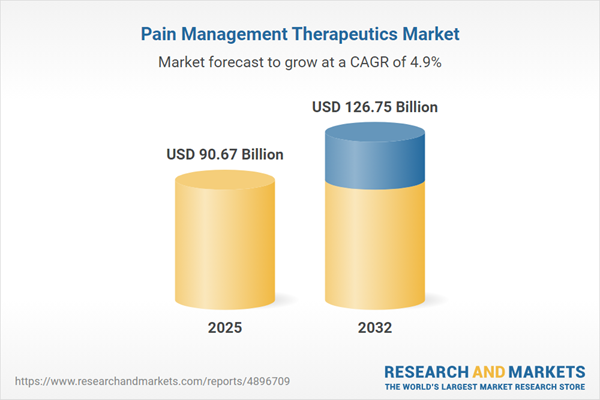Speak directly to the analyst to clarify any post sales queries you may have.
Senior executives in healthcare and pharmaceuticals are navigating a transformative landscape as the pain management therapeutics market advances. With regulatory shifts, digital technologies, and evolving patient needs reshaping the sector, actionable market intelligence is vital for making resilient, evidence-based decisions that support both care delivery and operational success.
Pain Management Therapeutics Market Snapshot
The global pain management therapeutics market currently stands at USD 86.51 billion, projected to grow at a CAGR of 4.89% through 2025. This positive outlook is driven by diagnostic breakthroughs, personalized therapies, and the expanding adoption of digital health initiatives. Greater regulatory focus on safety is shifting the industry away from traditional opioid treatments. Instead, biologic and innovative non-opioid alternatives are shaping strategic priorities. Market participants are adapting their operations and clinical approaches to keep pace, ensuring compliant, patient-centered, and scalable solutions across established and emerging healthcare environments.
Pain Management Therapeutics Market: Scope & Segmentation
This comprehensive report empowers decision-makers by outlining essential pathways for entry, performance optimization, and long-term competitiveness in pain management therapeutics. The segmentation below enables benchmarking, portfolio alignment, and anticipation of emerging patient and operational needs:
- Drug Class: Includes adjuvant analgesics, local anesthetics, neuropathic agents such as anticonvulsants and antidepressants, NSAIDs, Cox-2 inhibitors, and opioids. Insightful analysis aids in shaping product pipelines to address the full range of pain presentations, allowing organizations to diversify and target high-need areas.
- Route of Administration: Oral, parenteral, topical, and transdermal methods are assessed, supporting decisions tied to real-world adoption, patient adherence, and effective management in acute and chronic care settings.
- Indication: Segments examined include acute pain, chronic pain, cancer-related pain, neuropathic and inflammatory disorders, osteoarthritis, and rheumatoid arthritis. These categories clarify where to focus investments in both R&D and commercialization.
- Distribution Channel: Both online and offline channels are tracked, highlighting the evolution of procurement behaviors among institutions and the growing role of digitalization in purchasing and supplier relations.
- End User: Covers ambulatory surgical centers, public and private hospitals, home care providers, hospice services, and direct-to-patient models. This segmentation ensures strategies remain flexible to fit various clinical and non-clinical settings.
- Regional Coverage: Analysis spans North America, South America, Europe, Middle East & Africa, and Asia-Pacific, with market access and compliance perspectives for regions such as the US, Canada, Brazil, China, India, Japan, and Australia. This supports understanding operational variability and local regulatory intricacies.
- Companies Profiled: Strategic insights and benchmarking are provided for leading participants including Johnson & Johnson, Pfizer Inc., Novartis AG, Bayer AG, GlaxoSmithKline plc, Sanofi S.A., Teva Pharmaceutical Industries Ltd., Endo International plc, Mallinckrodt plc, and AstraZeneca plc.
Pain Management Therapeutics Market: Key Takeaways
- Adoption of biologic and non-opioid treatments reflects organizational emphasis on patient safety and evolving regulatory criteria, guiding investment and innovation priorities.
- Personalized and biomarker-based care allows for deeper collaboration between manufacturers and providers, supporting durable treatment outcomes across diverse patient groups.
- Digital health, including AI-driven diagnostics and telemedicine, is expanding access to care, especially in markets with limited infrastructure, enabling improved operational reach.
- Timely adaptation of compliance protocols and flexible resource strategies is essential for staying ahead of rapidly changing regulatory and operational demands.
- Increasing use of real-world evidence strengthens negotiations with payers, supports value-based reimbursement models, and enhances the justification for investment in advanced therapies.
- Efficient supply chain and inventory management are becoming more important as organizations expand across regions, securing steady product availability and mitigating supply disruptions.
Tariff Impact: Addressing Supply Chain and Cost Pressures
Rising tariffs on raw materials and finished pharmaceuticals are increasing procurement costs and elevating supply chain complexity. To maintain operational agility, executives are forming regional partnerships, implementing nearshoring strategies, and overhauling logistics infrastructure. These initiatives are increasingly critical for containing costs, minimizing disruptions, and adapting to interconnected global market dynamics.
Methodology & Data Sources
This analysis synthesizes insights from senior-level interviews across clinical, healthcare, and supply chain roles. It is enhanced by the latest industry research, regulatory updates, and proprietary survey data, offering a robust view of strategic risk and future planning within leading organizations.
Why This Report Matters
- Enables leadership to refine portfolios and optimize supply chains to address local and regional variations.
- Supports strategic planning and partnership formation through clarity on evolving regulations and stakeholder expectations.
- Anticipates regulatory and operational challenges, equipping organizations to transform processes and meet changing global requirements.
Conclusion
With reliable market insight, executives can build organizational resilience, drive meaningful innovation, and sustain competitive positioning as the pain management therapeutics sector evolves. Staying informed is central to shaping future market success.
Additional Product Information:
- Purchase of this report includes 1 year online access with quarterly updates.
- This report can be updated on request. Please contact our Customer Experience team using the Ask a Question widget on our website.
Table of Contents
3. Executive Summary
4. Market Overview
7. Cumulative Impact of Artificial Intelligence 2025
Companies Mentioned
The companies profiled in this Pain Management Therapeutics market report include:- Johnson & Johnson
- Pfizer Inc.
- Novartis AG
- Bayer AG
- GlaxoSmithKline plc
- Sanofi S.A.
- Teva Pharmaceutical Industries Ltd.
- Endo International plc
- Mallinckrodt plc
- AstraZeneca plc
Table Information
| Report Attribute | Details |
|---|---|
| No. of Pages | 189 |
| Published | October 2025 |
| Forecast Period | 2025 - 2032 |
| Estimated Market Value ( USD | $ 90.67 Billion |
| Forecasted Market Value ( USD | $ 126.75 Billion |
| Compound Annual Growth Rate | 4.8% |
| Regions Covered | Global |
| No. of Companies Mentioned | 11 |









